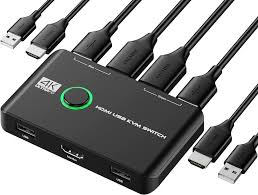Imagine your workspace as a symphony of efficiency; each computer seamlessly taking its turn in the limelight, all orchestrated effortlessly.
How can you achieve this level of harmony? Enter the world of KVM switches. With the power to simplify your computer management tasks, these devices hold the key to a more organized and streamlined setup.
But how exactly do they work, and what benefits do they bring to the table? Let’s explore the realm of KVM switches together and unlock their potential for optimizing your computer systems.
Benefits of Using a KVM Switch
Streamlining your computer management becomes effortless with the use of a KVM switch. Imagine the convenience of controlling multiple computers using just one set of peripherals. With a KVM switch, you can seamlessly switch between different computers with a simple keystroke or push of a button. This not only saves you valuable desk space but also eliminates the need for multiple keyboards, monitors, and mice cluttering your workspace.
One significant benefit of a KVM switch is the time-saving aspect. Instead of physically moving between multiple computers, you can efficiently manage them from one central location. This not only boosts your productivity but also reduces the frustration of dealing with tangled cables and a confusing array of devices.
Furthermore, a KVM switch promotes efficiency by allowing you to multitask effectively. Whether you’re a professional requiring access to various systems or a gamer switching between different setups, a KVM switch ensures a seamless and streamlined computing experience.
How a KVM Switch Works
To understand how a KVM switch works, it’s essential to grasp the fundamental mechanism behind its operation. Essentially, a KVM switch allows you to control multiple computers using a single set of peripherals. When you connect your keyboard, video monitor, and mouse to the KVM switch, it acts as a central hub. By pressing a button or using a keyboard shortcut, you can switch between different connected computers seamlessly.
The KVM switch works by capturing the input from your peripherals and directing it to the selected computer. This switching process all happens in real-time, enabling you to manage various systems efficiently. Additionally, the KVM switch preserves the quality of the video signal, ensuring that you experience no degradation or lag while switching between computers.
Types of KVM Switches Available
Various KVM switches are available on the market to cater to different computer management needs. The most common types include desktop KVM switches, rack-mounted KVM switches, and IP-based KVM switches.
Desktop KVM switches are compact and ideal for personal or small office use, allowing you to control multiple computers from a single console. Rack-mounted KVM switches are designed for server rooms or data centers, where space optimization is crucial. They can control numerous servers efficiently from a centralized location.
IP-based KVM switches offer remote access capabilities, enabling you to manage servers and systems from anywhere in the world using an internet connection. These switches are suitable for businesses with multiple branches or for IT professionals who require remote troubleshooting abilities.
Additionally, some specialized KVM switches support features like audio support, USB hub functionality, and multi-monitor setups to enhance user experience. When choosing a KVM switch, consider factors such as the number of computers to be managed, required features, and future scalability to ensure seamless computer management.
Setting Up a KVM Switch
When setting up a KVM switch, ensure that you have the necessary cables and peripherals ready for a smooth installation process. Start by connecting the KVM switch to your computers using the appropriate cables. Typically, these connections include VGA, USB, and audio cables. Make sure to follow the manufacturer’s instructions for the correct ports on both the switch and your computers.
Next, connect your monitor, keyboard, and mouse to the designated ports on the KVM switch. This step ensures that you can control all connected computers using a single set of peripherals. Double-check all connections to avoid any issues with device recognition or functionality.
Once everything is connected, power on the KVM switch and all connected computers. You should now be able to switch between computers using the designated hotkeys or buttons on the KVM switch. Test the setup by accessing each computer to confirm that the switch is working correctly. If you encounter any issues, refer to the user manual for troubleshooting tips.
Tips for Optimizing KVM Switch Performance
For optimal performance with your KVM switch, prioritize updating firmware regularly to ensure compatibility with your devices and maintain efficiency. This step is crucial as firmware updates often include bug fixes and enhancements that can improve the overall functionality of your KVM switch.
Additionally, organizing your cables neatly and ensuring they’re of high quality can help prevent signal interference and reduce the risk of connectivity issues.
When connecting devices to the KVM switch, make sure to use the appropriate ports to avoid overloading any single channel. It’s also recommended to power cycle your KVM switch occasionally to refresh its settings and clear any potential glitches.
Lastly, consider adjusting the video resolution settings on your devices to match the capabilities of your KVM switch for smoother operation.
Conclusion
In conclusion, using a KVM switch can greatly simplify computer management by allowing you to control multiple computers with one set of peripherals.
With various types available and easy setup, optimizing performance is key.
Consider the benefits and how a KVM switch works to streamline your workflow and increase efficiency.
Make the most of your technology with this handy tool.
